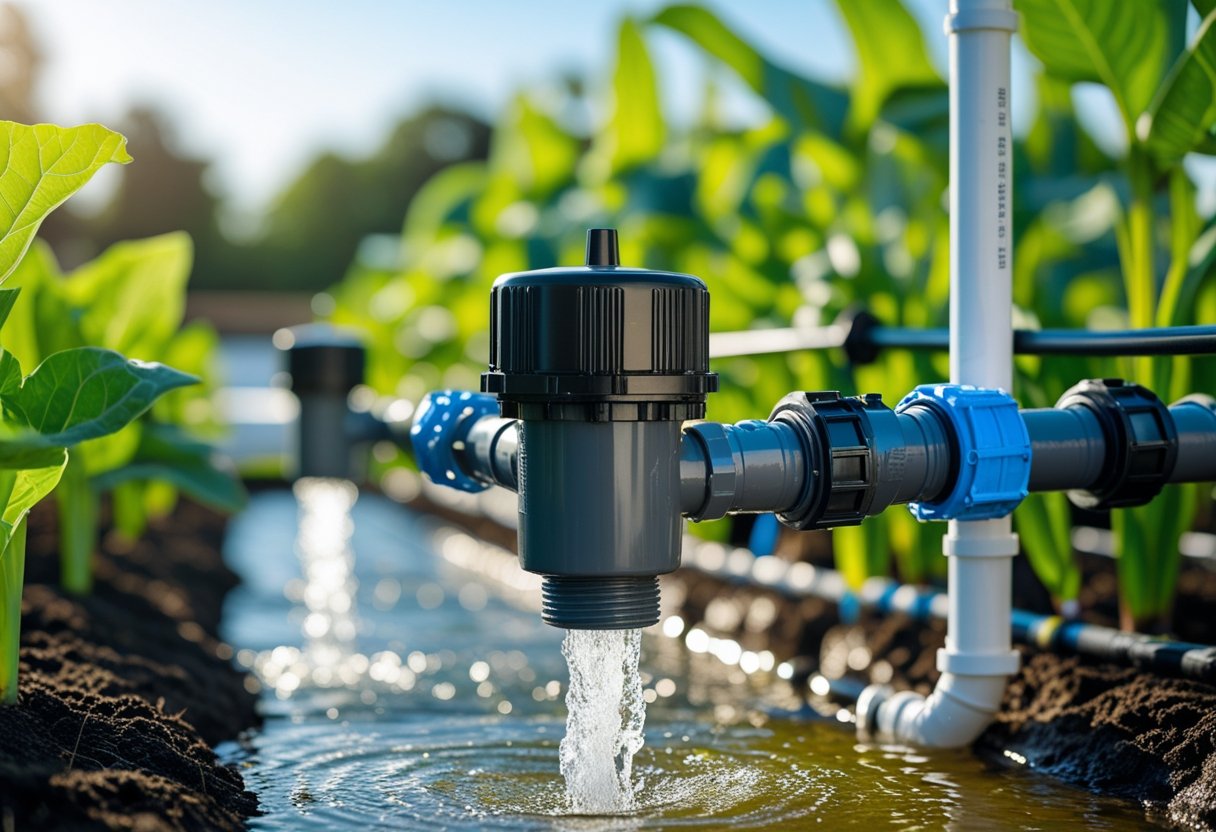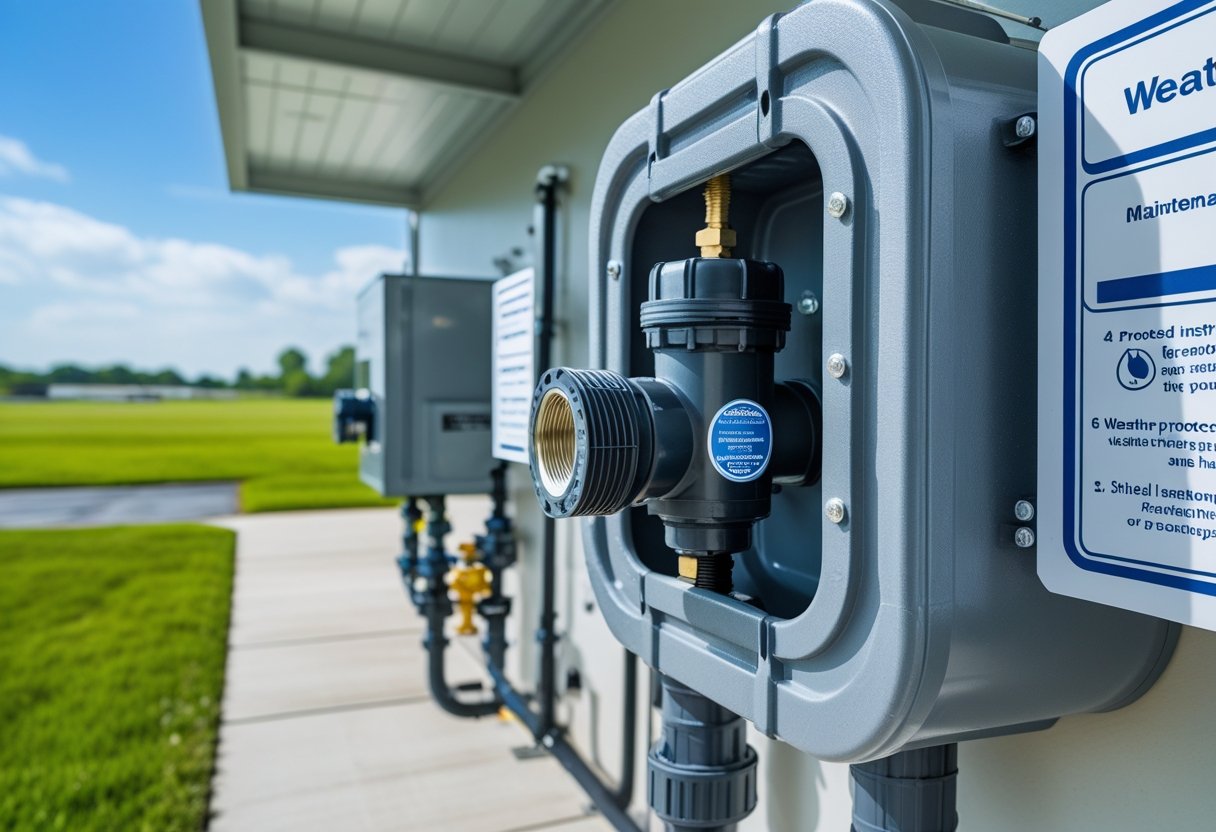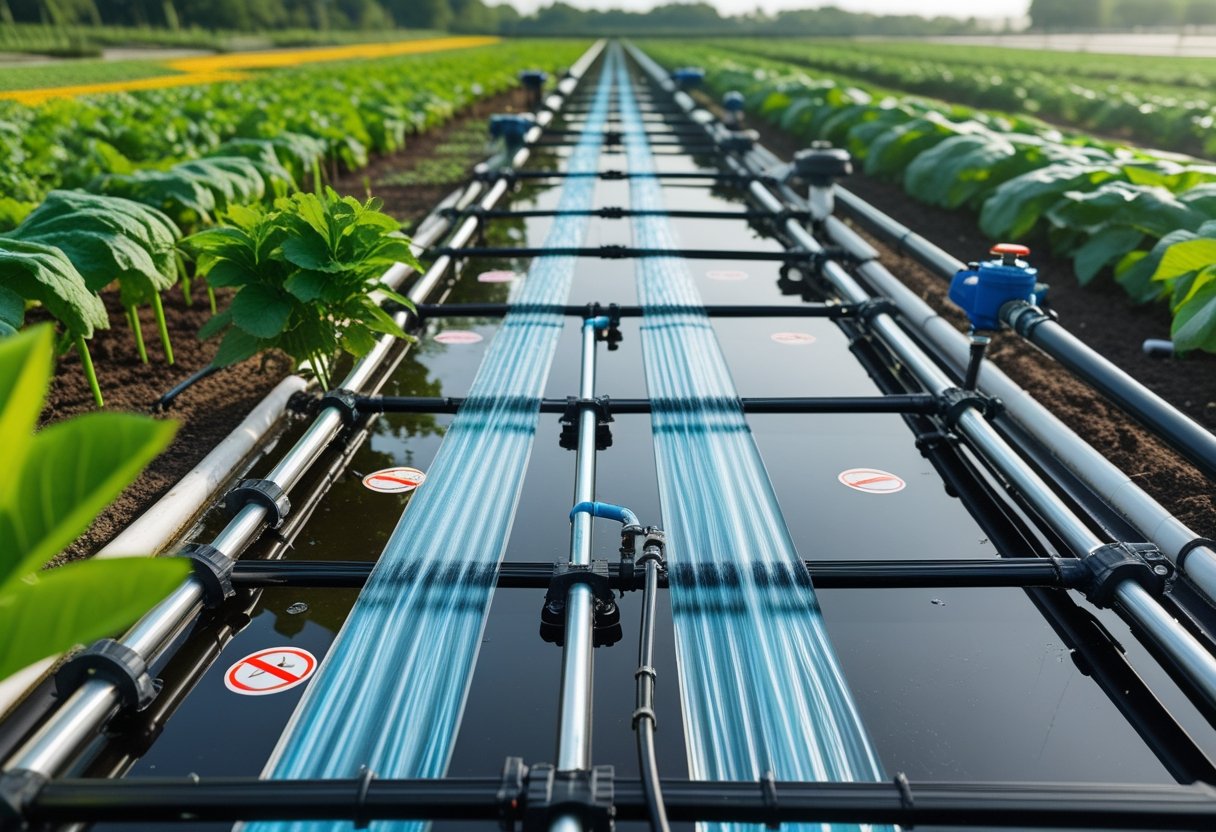Keeping your irrigation backflow preventer in good shape protects your home’s water supply from contamination. Regular maintenance, like testing, cleaning, and repairs, keeps your system safe and up to local standards.
This prevents leaks and avoids costly damage. You don’t have to figure it all out on your own.
With simple steps like scheduling annual backflow tests and tracking repairs, you can keep your device reliable. Knowing what to watch for and how to respond saves you time and money.
In this guide, you’ll learn practical tips to maintain your backflow preventer. We’ll cover basic care and when to call professionals.
Understanding Irrigation Backflow Preventers
Backflow preventers keep your irrigation system from contaminating your water supply. Knowing the different types, how they work, and why they matter helps you maintain your system.
Types of Backflow Preventers
There are several common types of backflow preventers for irrigation systems. The main ones are:
- Pressure Vacuum Breaker (PVB): Prevents back-siphonage and works well for residential irrigation systems.
- Atmospheric Vacuum Breaker (AVB): Simple and inexpensive, protects mainly against back-siphonage.
- Reduced Pressure Zone (RPZ): Protects from backpressure and back-siphonage, used in more complex or commercial systems.
Choose a type based on your system’s needs and local codes. Knowing your type helps with maintenance and repair.
How Backflow Preventers Work
Backflow preventers stop water from flowing backward into your clean water supply. They allow water to flow one way: out to your irrigation system.
If water tries to flow back, valves or air gaps block the reversed flow. This keeps fertilizers, pesticides, or dirt out of your drinking water.
Check all parts regularly to make sure they move freely and seals hold tight. This prevents leaks or contamination.
Why Backflow Prevention Is Vital
Without a working backflow preventer, harmful substances can flow back into your water system. This can cause health risks for you and your neighbors.
Many local water districts require backflow preventers by law. Failing to maintain or test your device could result in fines or water shutoff.
Routine Inspection Procedures
Check your irrigation backflow preventer regularly to keep it in good shape. Look for leaks, test how well it works, and watch for worn parts.
These steps help protect your water and keep your system running smoothly.
Visual Checks for Leaks and Damage
Look closely at your backflow preventer for leaks. Check around joints, valves, and fittings for water dripping or pooling.
Examine the device for cracks, rust, or broken parts. Damage from weather or impacts can affect performance.
Make sure protective insulation or cages are secure and intact. Use a flashlight to check hard-to-see spots.
Write down what you find and schedule repairs if you spot leaks or damage.
Testing Devices for Proper Function
Testing ensures your backflow preventer stops dirty water from flowing backward. A licensed technician uses special equipment for this job.
The technician measures water pressure and checks valve operation. They test each part to confirm it opens and closes at the right time.
If the device fails any part of the test, it may need repairs or replacement. Annual testing is usually required by local regulations.
Identifying Signs of Wear
Signs of wear include stiff valves, unusual noises, or slow water flow. These mean parts may be breaking down.
Look for corrosion on metal parts and cracked, dry, or swollen rubber seals. These reduce the device’s ability to keep water flowing correctly.
Keep a schedule for inspections to catch wear early. Replace worn parts promptly to avoid bigger repairs.
Cleaning and Flushing Techniques
Keep your irrigation backflow preventer clean for proper working condition. Focus on removing debris and flushing the system correctly.
Removing Debris from Devices
Dirt, leaves, and sediment can block valves and parts inside your backflow preventer. Turn off the water supply before cleaning.
Use a soft brush or cloth to clean the exterior and visible parts. Open access points to check for debris inside.
Remove particles by hand or with a small vacuum. Avoid harsh tools that could damage seals or valves.
Check for corrosion or worn parts. Call a professional if you find damage.
How to Flush the System Safely
Flushing clears out dirt or clogged parts. Connect a hose to the test cocks or flushing points.
Open the valve slowly to let water flow at low pressure. Watch for clear water without debris.
Flush for a few minutes to push out all sediment. Then, close the valves and turn the main water supply back on.
Do not flush with high pressure or use chemicals. Regular flushing keeps your system clean and reduces repairs.
Annual Maintenance Tasks
Do a few key tasks each year to keep your backflow preventer in good shape. Prepare it for winter, have a professional inspect it, and replace worn parts.
Winterizing Backflow Preventers
Before cold weather, drain your backflow preventer to stop water from freezing inside. Frozen water can crack valves and pipes.
Turn off the water supply and open all test cocks to drain water. Remove the device if you live where freezing is severe.
Check for leftover water and make sure the device is dry. Call a pro if you’re unsure about draining it yourself.
Professional Inspection Recommendations
A certified technician should inspect your backflow preventer every year. They test valves, check for leaks, and clean out debris.
Professionals spot small issues before they become big problems. They document the inspection for local compliance.
If your device fails any part of the check, the technician will recommend repairs or replacement.
Replacing Worn Parts
Parts like rubber seals, discs, and springs wear out over time. These stop dirty water from flowing backward.
Look for signs of leaks or low water pressure. These usually mean parts need replacing.
Use only parts that match your device’s model and local codes. Hire a certified technician if you’re not comfortable making replacements.
Common Problems and Solutions
Know common problems with your irrigation backflow preventer and how to fix them quickly. Some issues cause false alarms or poor water flow.
Troubleshooting False Backflow
Sometimes, your backflow preventer may show backflow signs when there isn’t any. Debris in the valve or worn-out parts like springs and O-rings can cause this.
Clean the valve by flushing out debris. Replace worn O-rings and springs.
Check that the preventer is installed correctly. Regular testing catches these problems early.
Fixing Low or No Pressure Issues
Low water pressure near your backflow preventer can signal problems inside the device. Clogged valves, stuck check valves, or mineral buildup are common causes.
Inspect for blockages and clean the valve. Flush the device every 6 to 12 months if mineral buildup is an issue.
Check springs and moving parts to ensure they move freely. Replace stuck or damaged parts.
Call a professional if pressure issues continue.
Proper Record Keeping
Keep detailed records to stay organized and meet legal requirements. Tracking maintenance and repairs helps keep your backflow preventer working safely.
Tracking Maintenance Dates
Write down every inspection, test, or service for your backflow preventer. Use a calendar or spreadsheet to mark dates.
Set reminders before tests or servicing to avoid missed deadlines. Add notes about unusual activity or system changes.
Documenting Repairs and Tests
Record every repair or test result. Include the date, what was fixed or tested, the technician’s name, and parts replaced.
Store records in one place for easy access. Clear documentation proves your system meets local rules.
Preventive Tips for Long-Term Performance
Protect your irrigation backflow preventer from weather and use the right parts. These steps keep your system working and avoid costly repairs.
Protecting Devices from the Elements
Backflow preventers are often outside, so rain, sun, and cold can cause damage. Cover the device with a weatherproof enclosure or insulated box.
Check the cover for cracks or holes. A tight seal keeps out debris and pests.
Clean around the device to prevent dirt buildup. Clear leaves, dirt, and grass clippings from the area.
Using Compatible Irrigation Components
Use parts that match your backflow preventer. When replacing hoses, valves, or sprinkler heads, choose ones made for your system.
Check that your irrigation system’s pressure matches the device’s ratings. Use pressure regulators or gauges to keep pressure steady.
Follow manufacturer guidelines for installation and repair. Using the correct tools and approved parts keeps your system compliant and reliable.
Understanding Local Regulations
When you maintain your irrigation backflow preventer, you need to know your local rules. Many water districts require yearly testing to keep your water clean and safe.
If you ignore these rules, you could face fines or unsafe water. Your backflow preventer must pass regular tests.
Certified technicians check that your device works and keeps dirty water out of your clean supply. If your device fails, you need to repair or replace it to meet local codes.
Here are some common requirements you might encounter:
- Annual Testing: You must have your backflow preventer tested every year by a certified tester.
- Reporting: Send test results to your local water authority to prove compliance.
- Repairs & Replacements: Fix or replace devices that fail tests with approved equipment.
- Installation: Use backflow preventers that meet local safety standards in new systems.
Some properties, like homes with irrigation systems, pools, or boilers, must have backflow preventers. These rules protect your family and neighbors by stopping contaminated water from flowing back into the public supply.
Frequently Asked Questions
Maintaining your irrigation backflow preventer keeps your water safe and your system working well. Knowing how to protect it from winter damage, install it properly, and spot problems early can save you time and money.
What are the steps for winterizing irrigation backflow preventers?
Drain all water from your backflow preventer before freezing weather arrives. After draining, insulate the device with foam covers or wraps to protect it from the cold.
Avoid leaving water inside because frozen water can cause damage.
What should I consider when installing a residential irrigation backflow preventer?
Install the backflow preventer in an easy-to-access spot for maintenance. Place it on the main water line before your irrigation system.
Use certified parts and follow local codes to protect your water.
How often should I inspect my backflow preventer to ensure optimal functionality?
Inspect your backflow preventer at least once a year. Some areas require annual testing by certified technicians.
Look for leaks, damage, or unusual water flow during inspections to catch problems early.
Is it necessary to perform regular maintenance on my irrigation backflow preventer?
Yes, regular maintenance prevents leaks and keeps your system safe. Clean, test, and repair the device as recommended or when you notice problems.
What are common issues to look out for that could indicate my irrigation backflow preventer is leaking?
Watch for water leaking from the vent or pipes connected to the preventer. Worn diaphragms or damaged seals often cause leaks.
If you see water pooling or hear hissing sounds, you may need to repair or replace the device.
Can you explain the benefits of using a drip irrigation system with a backflow preventer?
A drip irrigation system with a backflow preventer ensures water flows in only one direction. This setup stops contaminants from entering your clean water.
Drip irrigation delivers water directly to plants. This method saves water and keeps your supply safe.











